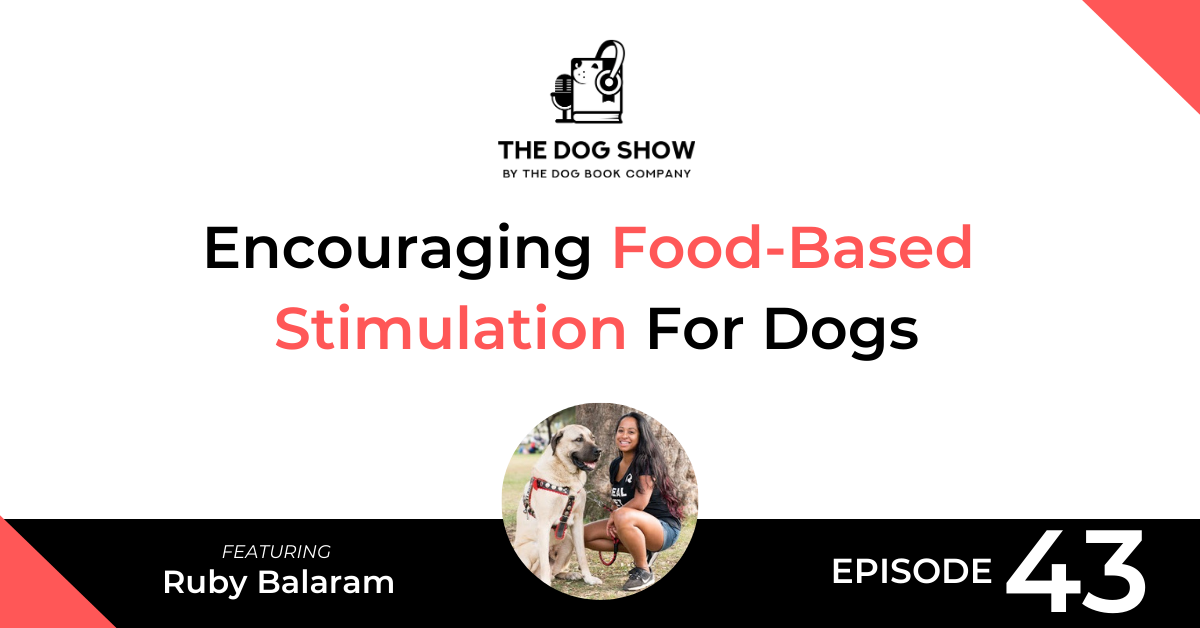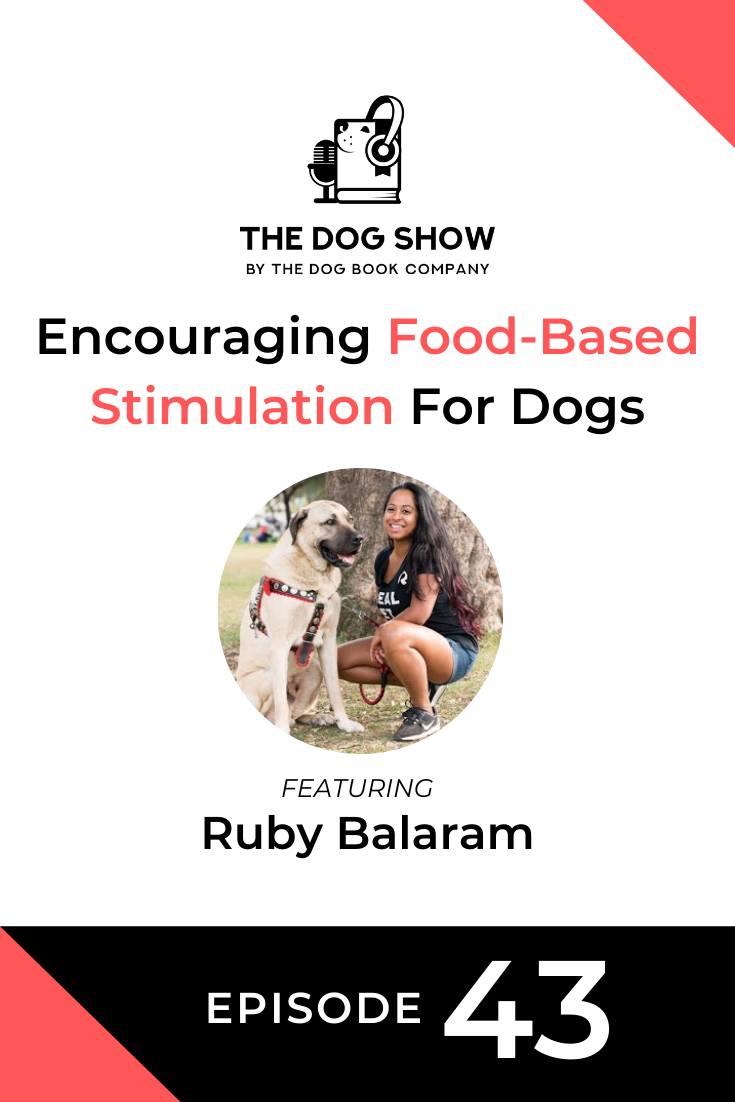
Do you use treats to train or stimulate your dog?
In this episode of The Dog Show, I discuss the behavioral benefits of regular food-based stimulation for dogs with Ruby Balaram.
Ruby is the COO and Co-Founder of Real Dog Box. Real Dog Box is a no-contract subscription service that delivers treats and chews to your home, based in San Diego, California.
Every four weeks, they make a new combo of food to help meet your dog’s nutritional needs. They hand-select and air-dry a variety of proteins in small batches from locally sourced meats, so your dog can enjoy them while they’re still fresh.
Find out more about Real Dog Box here:
Listen
Watch
Read
Will: This episode of “The Dog Show” features Ruby Balaram. Ruby is the COO and co-founder of Real Dog Box. Real Dog Box is a no-contract subscription service that delivers treats and chews to your home based in San Diego, California. Every four weeks, they make a new combination of food to help me your dog’s nutritional needs. They hand-select and air dry a variety of proteins in small batches from locally sourced meats, so your dog can enjoy them while they’re still fresh. In the interview, we discussed the behavioral benefits of regular food-based stimulation for dogs. Ruby, welcome to “The Dog Show” today. Thank you so much for coming on.
Ruby: Thank you for having me.
Will: Yeah. I’m excited to have a chat with you today. So you didn’t actually grow up with dogs, but you’ve got a very interesting story of how you ended up working in the pet food industry. So can you share a little bit about that with me?
Ruby: Yeah, absolutely. Well, you know, just because I didn’t grow up with a dog in the house, doesn’t mean they aren’t everywhere. I was one of those little girls that was actually scared of dogs. But there are, you know, family members have dogs, so you see them at airports, and you know, police dogs, service dogs just doing work. So I wasn’t like I was blind to them. But the way I got into this industry was when I met my co-founder in 2012. His family dog that he grew up with was a Doberman. And he had been diagnosed with testicular cancer a few years prior. And then, as his health was declining at 12 years old, we were told that he probably had cancer again, and we were going to go through the same kind of steps to get him back to good health. Although with older dogs, it’s a little harder because there’s a lifespan that they’re aware of. And, you know, you kind of are given the task to choose between giving them some comfort or getting them back to that puppyhood that they were once in. But anyway, during that time, you know, I was working in the legal field, and we did a deep dive into nutrition to figure out how we could get him back to good health. We learned about the fresh food movement, raw feeding, and decided to switch him to that diet, which, jeez, it changed his life. It changed my life. Because in that process, I learned a lot about the pet food industry, generally, marketing practices, things that were and still are legal to do. But in my mind, not transparent, not honest, and not really the right way to help people that love their beloved four-legged family members, by just telling them what to do and not, you know, explaining why. It just didn’t make a whole lot of sense to me. So long story short, as everybody says. You know, we learned about fresh food. And when I figured out that there was a better way to do all of this and to run a company and be honest with what is in your food, and why it’s good for your dogs, that’s what we set out to do.
Will: Yeah. I think because you’ve got a background in legal, right? And that would have been an interesting perspective on pet food, I imagine. Because the regulations from what I understand have improved in recent years, but they’re still a long way away from kind of human-grade food, right?
Ruby: Yeah. And, you know, I would actually venture to say that that’s the same for the human processed food industry. You know, there’s a lot of convenience behind that, and I get that. But when you can control the conversation with big dollars and marketing, kind of like the prescription, you know, pharmaceutical industry. It’s very similar in that way. And there have been a lot of improvements, I think because now the conversation is open and people are ready to talk about it. Then they ask questions. And when they ask questions, they demand more from their food manufacturer. And that’s really what’s taking us to the next step.
Will: Yeah, definitely. This might be a little bit of a tangent, but kind of what are people looking for? Like, what should they be on the lookout for when it comes to their dog food, or their dog treats and things like that? Are there a couple of warning signs that they should watch out for?
Ruby: Sure. Well, I think it starts with the ingredients followed by how a food is made. I am a fresh food advocate through and through and, you know, to some people that means a raw diet, for other people, that means lightly cooked. But really what it comes down to is what are you putting in there, you know, are there additives that are synthetic that could be replaced with a whole food source. Those are generally things that I try to steer clear from, as well as anything that requires a preservative for an extended shelf life. You know, there’s no reason to…for us outside of convenience, really, to not be eating fresh food all the time if we can. And I feel the same way about our dogs.
Will: So that’s how you’ve gone about with Real Dog Box. And obviously, that’s where you’re co-founder. Is that how you’ve gone about creating the treats and chews that you’ve got on offer there?
Ruby: Yeah, that’s exactly what we did. So, you know, we switched our dog to a raw diet, and I was working full time in legal and my co-founder was working for the federal government actually, at the time. So two very busy people that didn’t have time to be making their dog’s food every single week. Because it’s, it’s a lot, you know. It’s labor and time-intensive. And so, we were looking for the service in order to have the food made and delivered to us. And at that time, you know, that was not yet 10 years ago, but I want to say there were one or two companies that existed in America that even had that service. And it’s pricey, you know, logistically to ship out frozen food is hard. But we have this concept in mind and we said, you know, nobody’s doing this right now. It would really help if someone would make our food and deliver it to us. And so, that’s what we set out to do. But we ran into some of those hurdles. You know, we had that same food philosophy in mind, always, which is eating fresh, minimal ingredients, minimal processing, as best as we could. When then we realized, wow, it’s really hard to enter the market with a frozen product. I mean, the amount of packaging and insulation that’s involved, and even, you know, on top of that running a business is telling people who you are and why they should buy something from you. What we ended up doing was taking all of the ingredients for our meals, the raw meals that we were going to make, cannibalizing them, separating them out, and just drying them as individual products. So that’s how the whole thing kind of unfolded with Real Dog Box because we want it to feed fresh, and we want it to be a gateway for people to make their own food at home. And that’s still the same thing that we’re doing now.
Will: That’s interesting, because I think, yeah, there are certainly today there’s numerous players in that space of home-cooked meals for dogs. But I feel like there’s far fewer players in the treats space.
Ruby: Well, it’s a difficult… You know, they say there’s three things you shouldn’t talk about at the dinner table, which is religion, politics, and dog food.
Will: I haven’t heard that one. Maybe that’s a sign that you’re familiar.
Ruby: Maybe that’s an American thing. Because it’s a sensitive topic, you know. It’s like telling someone what they should and shouldn’t feed their kid because they know better than you do. And so yeah, a lot of people think that the treat space is it’s not novel. And it isn’t, you know, it’s not something that really disrupts the industry. But when you’re trying to be the bridge or the gateway to help people transition to fresh food, then you’re opening up a different avenue for them. And it encourages them to ask questions about, “Oh, well, why should I feed this? Why is this a better option?” And those are the conversations that we haven’t been having for years.
Will: Yeah. So one question I had when you were talking about how you prepared the treats, you spoke about drying. So that drying process, does that just extend the shelf life of the food?
Ruby: Yeah, that’s exactly what it does. So we refer to it as air drying. We don’t exceed 130 degrees Fahrenheit in temperature. And the idea is to mimic sun drying. So my co-founder is from Turkey, and he tells me stories all the time of how they’d have, you know, sun-dried tomatoes, or eggplant, or meat, you know, just outside or on their rooftops, which would get to a certain temperature because they, you know, had to extend the shelf life of their food and make sure they had food for the following weeks and months. So you don’t have to add anything. And it’s different than curing a meat, for example, with salt. It’s simply removing the moisture from the food using a low temperature so you’re not changing the cell structure or reducing the nutritional value as you would if you had to cook it. And so, we just mimic that process in a controlled facility.
Will: Okay. And how long do your treats last for?
Ruby: They usually last up to 60 days or more. The thing is once you open up the bag, you’re exposing it to some sort of natural moisture or humidity that’s in the air. I actually have…not here. I’m in the home office but at the shop, I have our very first box that we made that’s five years old, and the treats are still in perfect condition. I mean, they haven’t been exposed to anything. We haven’t opened them up because…if they’re not tampered with, they last pretty long.
Will: So you’re gonna keep that forever, I guess?
Ruby: Yes. I’m going to try to. We do tell people though, as with anything that you want to kind of maintain, keep it in a cool, dry place. And so we have a lot of members that keep their treats in the fridge or the freezer. A lot of people have their own dog freezers as well.
Will: Yeah. Yeah, that’s nice. So you spoke about the health benefits briefly when you were talking about your story and your partner’s Doberman and things like that. I mean, that was a…I guess, a powerful story because the dog had cancer, and then like changing diet really helped him. But what are the health benefits, or I guess the scientific health benefits of unprocessed foods?
Ruby: Sure. Well, really the same as ours. So anytime we have…we consume things that our body don’t need…the bodies don’t need, we see things like obesity or diabetes. And these are…a lot of these health issues are things that you see more than once. If you have one, you sometimes have another, you know, the high blood pressure and all of that. What I have seen the best health benefit from eating an unprocessed treat or a chew are the dental benefits. Like just the cleaning of the teeth that don’t require you to stick a toothbrush in your dog’s mouth, because that’s not natural for anyone. And the benefits of naturally taking off any built-up plaque or tartar. A lot of people come to us when their dogs suffer from allergies. Because oftentimes, they suspect a particular protein, you know, it’s chicken. That’s the one that we hear all the time. My dog’s allergic to chicken, so I need to feed single ingredient treats. And oftentimes what we learn is that it’s the other ingredients that are made in a dry kibble, for example, that are actually causing the allergy or the inflammation. And so, any sort of inflammation, I mean, if you’ve experienced that yourself, I’m sure it can be anything from an itchy skin to an upset stomach, you know, inflamed bowels. And when you don’t have that, you tend to live a happier and more comfortable lifestyle. And we’ve seen the same thing with our dogs.
Will: Yeah. The allergies one is an interesting one. I’ve experienced that with my dog. We went through this whole process of trying to identify what potential foods or environmental stimulants were causing these allergies. I think in the end, it turns out, it’s a combination. But from a food perspective, we even went from meats to…it was like a feather-based kibble or something like that, which was meant to be like give you the protein of the meats, but it wasn’t meant to have the meats, which would potentially cause the allergies, and she was still having a reaction to that food. And we switched across to a fully home-cooked diet that we chose exactly what it…what went into the mix and all that kind of stuff. And ever since then it’s significantly helped her.
Ruby: That’s great. Yeah. I think once you know what you’re putting in the bowl, it makes all the difference because you can take things out and replace it. When it’s all mixed together before you get it, you’ve no idea what it is.
Will: Yeah, yeah, exactly. Another element, I guess we’re talking about the health side of things. Another element, especially with Real Dog Box, because the way your service works is it’s a fresh box of treats or chews turning up every month, I believe.
Ruby: That’s right.
Will: So I guess the other element is the enjoyment or the stimulation that the dog’s getting from that occurring every month? Like what are the kind of benefits from that perspective?
Ruby: Sure. Well, we all know our dogs have a natural urge to chew. We’ve seen it in our shoes, and our coffee tables, and other furniture. It’s how they explore the world. You know, it’s how they learn what something is and isn’t. And so, what we have seen from our chews is it not only does it have the nutritional benefits, but we are able to see when dogs have that mental stimulation, either from using a particular chew that’s very, very challenging and it offers the jaw exercise, or even making it more challenging by putting it in a…in a chew holder. For the treats, we’ve seen so many people use puzzles, you know, and our dogs want to work. We all know that. They want to have a job. And part of those treat puzzles that we’ve created them, the modern dog owners, is being able to find something, look for something, and it tires their brain out, oftentimes much faster than, you know, 40 minutes of physical activity.
Will: Hmm. So it’s more about that just kind of regular stimulation. I think that can help with numerous behavioral issues from what I understand. Because often, if what I’ve heard from trainers and other people I’ve spoken with, sometimes you might look at a symptom like a behavioral challenge a dog’s having. Maybe that, as you mentioned, chewing some shoes or some socks, or maybe they’re doing something else in the house they’re not meant to. But oftentimes that kind of relates back to the fact that they’re not getting the required stimulation they need in the day, which is, you know, [crosstalk 00:15:12] I think that needs to be, as you said, exercise and activity. But there’s other ways that you can kind of give you that stimulation as well.
Ruby: Definitely. And, you know, we know that there’s a spectrum of the mental capacity of different dogs. I’ve got a large dog, so I…his ability, his mental endurance is far shorter than, say, a Border Collie or an Australian Shepherd, who are…they’re just wicked smart, and they want to work. And how do you do that when, you know, typically, we work at nine to five, and we can’t really offer much outside of…all right, well, let’s go to…for a walk after work or before work. So we tend to see that not only are their mind stimulated, but they feel challenged. And, you know, when you see the disruptive activity, oftentimes, that’s…it’s just a sign of boredom, or as you said that they’re not really getting the fulfillment that they need.
Will: Yeah, exactly. Maybe, potentially, they’re acting out because they’re not getting that stimulation. So how do you…you seem very educated about everything that’s going on in, I guess, the dog nutrition and dog food space. How are you keeping up to date with that? And is there any trends that you see in the future, which are coming into this space?
Ruby: We self-educate. You know, the way that…once that whole thing happened in 2015 and we were trying to figure out, “All right, how are we going to bring our dog back to good health?” We started with…we lived in D.C. at the time, in Washington, D.C. And we started with the National Zoo, head of nutrition, and we said, “What do you feed your canines and felines that you have here at the National Zoo?” And the very obvious answer was meat. “Oh, okay, great start.” And then, we really started to do a deep dive into research. I actually flew out to Australia. I met with Tom Lonsdale who, as you might know, is one of the raw food, fresh food movement pioneers. And I spent a few days with him to really understand how this all came about. And when you’re talking to someone like that, it’s just so obvious. He’s like, “Oh, these marketing trends. These pictures on the bags, like they mean nothing. Look at your dog.” And he’s got this model of…a 3D model of dogs and their jaws and their teeth, and it just became so apparent. And then, you come back here, and you’re kind of inundated with all these other, you know, marketing pamphlets. But when you find people like that, they tend to congregate together. And because it’s such a passion of theirs, you continue following them and all the studies that they’re able to put together. I just bought this book, actually, by Carter Brady, that has been on my nightstand. I’ve actually been carrying it with me for the past three days. There are so many people that are involved and invested in learning more about dog nutrition and kind of getting us back to that fresh food movement, that it’s easy to kind of follow along their studies as they continue to uncover a lot of information.
Will: That’s great. I mean, you are really doing a lot of good work in this space in terms of just, I guess, educating people about what is going into their dog’s bodies. And I feel like owners in general are looking for more information these days and wanting to be more educated. But it’s good to be aware of, you know, looking beyond the marketing content, I think.
Ruby: Yeah. And, you know, that’s really the goal for us. I always joke that I’m not a very good salesperson because I don’t want to convince anyone to do something they don’t want to do. What I want to do is give them the information so they could make a better decision for themselves and for their dogs. And part of that is encouraging people to ask questions, you know, ask more from your dog food maker. Ask them why they’re using that…those ingredients. Another question you asked about the trends that I think are going to happen soon because of this, because we are opening up this conversation, I think, as people become more involved with the food that they’re feeding their dogs, a lot of things are going to become far more localized. Because they want to have that conversation. They want to have the access to fresh food. I mean, we see the trends in human food, and I think both the positives and the negatives are replicating themselves in the pet food industry. And you know, something that we want to do and continue to do is build that local community, reduce the carbon footprint of how far food has to travel to reach our tables and reach our dog’s bowls. And I think that will become really, really popular here in the next coming years.
Will: Yeah. Well, you might not be trying to be a salesperson, but I think just your passion comes across about all of the, I guess, making food better for dogs, making the food better for the environment, all of that kind of great stuff. So you may not be trying to sell it to me, but I feel like you’ve sold it to me anyway.
Ruby: Thank you. Thank you.
Will: Where’s the best place people can go to find out more about Real Dog Box?
Ruby: You can go to our website. It’s real.dog. And we also have a YouTube channel, youtube.com/RealDogBox. We are putting out a lot of educational content. We have a very small but mighty story-telling team. And with them comes the ability to share everything that I have learned and all of that knowledge and use a bigger platform to do that. So they’re helping us kind of self-tell our story in that way.
Will: Perfect. Well, I’ll share the YouTube channel and the website real.dog which is really easy to remember. And I really appreciate you coming on “The Dog Show” today, Ruby. Thanks so much.
Ruby: Thank you.
From Our Store
-
French Bulldog Coffee Table Book – The Book of Frenchies
From: EUR €33.53 Add to cart -
Dachshund Coffee Table Book – The Book of Dachshunds
From: EUR €33.53 Add to cart -
Pug Coffee Table Book – The Book of Pugs
EUR €33.53 Add to cart -
French Bulldog Notebook – A5, Hardcover, PU Leather, 100gsm Lined Pages, Bookmark (Three Colours)
EUR €19.56 Select options -
Dachshund Notebook – A5, Hardcover, PU Leather, 100gsm Lined Pages, Bookmark (Three Colours)
EUR €19.56 Select options -
Pug Notebook – A5, Hardcover, Black PU Leather, 100gsm Lined Pages, Bookmark (Three Colours)
EUR €19.56 Select options -
French Bulldog Planner – PU Leather Exterior, Metal Loose Leaf Ring Binder, 100gsm Paper (Two Colours)
EUR €36.33 Select options -
Corgi Notebook – A5, Hardcover, Black PU Leather, 100gsm Lined Pages, Bookmark (Three Colours)
EUR €19.56 Select options -
Dachshund Planner – PU Leather Exterior, Metal Loose Leaf Ring Binder, 100gsm Paper (Two Colours)
EUR €36.33 Select options -
Vizsla/Weimaraner Notebook – A5, Hardcover, PU Leather, 100gsm Lined Pages, Bookmark (Three Colours)
EUR €19.56 Select options -
Cavoodle Notebook – A5, Hardcover, Black PU Leather, 100gsm Lined Pages, Bookmark (Three Colours)
EUR €19.56 Select options -
Beagle Notebook – A5, Hardcover, PU Leather, 100gsm Lined Pages, Bookmark (Three Colours)
EUR €19.56 Select options













